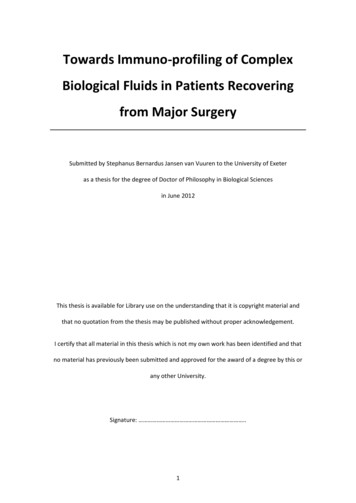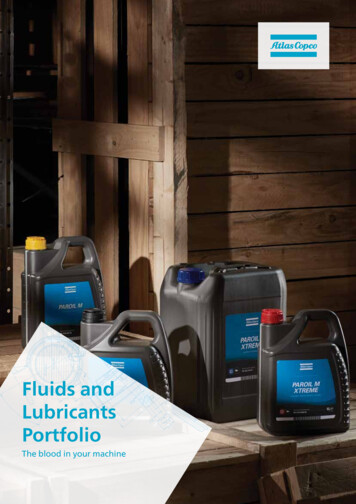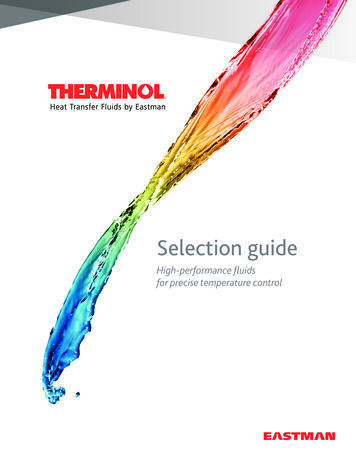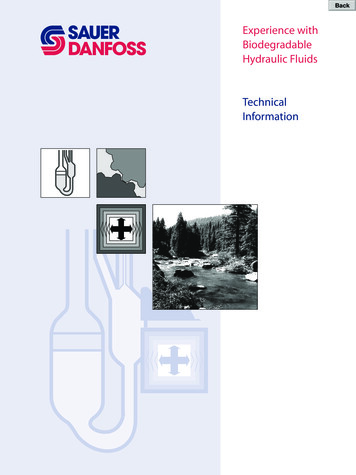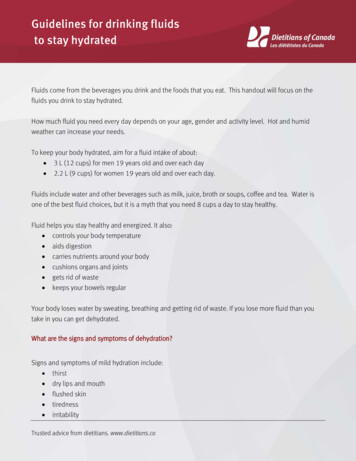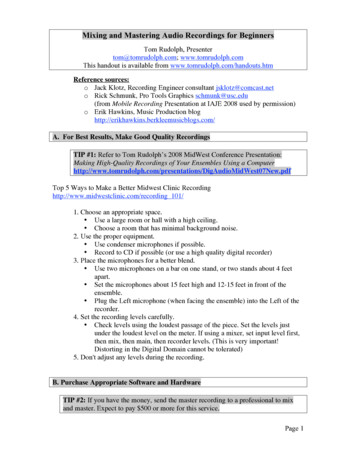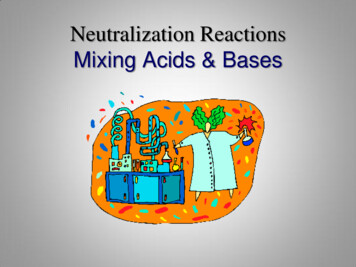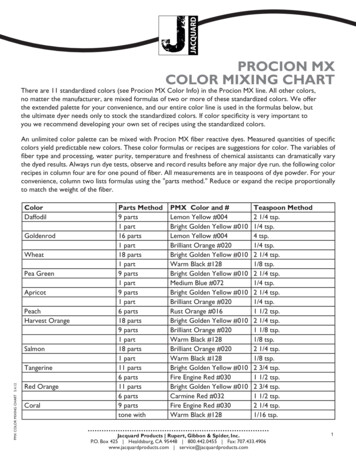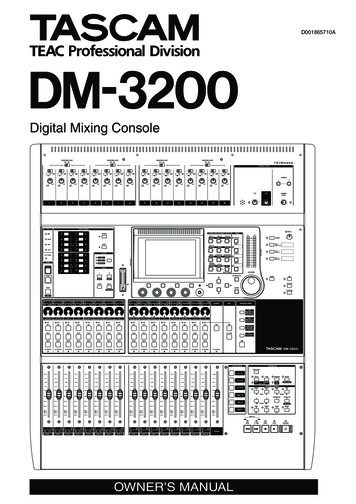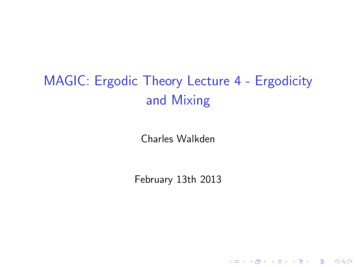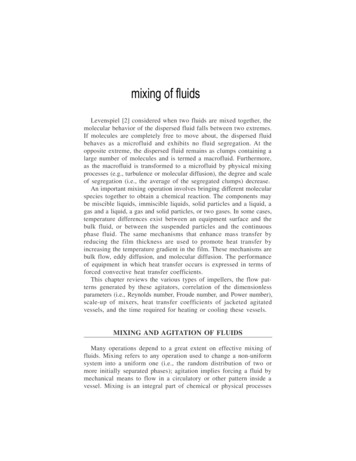
Transcription
mixing of fluidsLevenspiel [2] considered when two fluids are mixed together, themolecular behavior of the dispersed fluid falls between two extremes.If molecules are completely free to move about, the dispersed fluidbehaves as a microfluid and exhibits no fluid segregation. At theopposite extreme, the dispersed fluid remains as clumps containing alarge number of molecules and is termed a macrofluid. Furthermore,as the macrofluid is transformed to a microfluid by physical mixingprocesses (e.g., turbulence or molecular diffusion), the degree and scaleof segregation (i.e., the average of the segregated clumps) decrease.An important mixing operation involves bringing different molecularspecies together to obtain a chemical reaction. The components maybe miscible liquids, immiscible liquids, solid particles and a liquid, agas and a liquid, a gas and solid particles, or two gases. In some cases,temperature differences exist between an equipment surface and thebulk fluid, or between the suspended particles and the continuousphase fluid. The same mechanisms that enhance mass transfer byreducing the film thickness are used to promote heat transfer byincreasing the temperature gradient in the film. These mechanisms arebulk flow, eddy diffusion, and molecular diffusion. The performanceof equipment in which heat transfer occurs is expressed in terms offorced convective heat transfer coefficients.This chapter reviews the various types of impellers, the flow patterns generated by these agitators, correlation of the dimensionlessparameters (i.e., Reynolds number, Froude number, and Power number),scale-up of mixers, heat transfer coefficients of jacketed agitatedvessels, and the time required for heating or cooling these vessels.MIXING AND AGITATION OF FLUIDSMany operations depend to a great extent on effective mixing offluids. Mixing refers to any operation used to change a non-uniformsystem into a uniform one (i.e., the random distribution of two ormore initially separated phases); agitation implies forcing a fluid bymechanical means to flow in a circulatory or other pattern inside avessel. Mixing is an integral part of chemical or physical processes
Fluids Mixingsuch as blending, dissolving, dispersion, suspension, emulsification,heat transfer, and chemical reactions.Dispersion characteristics can be considered as the mixing of twoor more immiscible liquids, solids and liquids, or liquids and gases,into a pseudo-homogeneous mass. Small drops are created to providecontact between immiscible liquids. These liquids are mixed forspecific purposes, namely solvent extraction, removal or addition ofheat, and to affect mass transfer rates in reactors. The terms dispersionand emulsion are often used interchangeably. Dispersion is a generalterm that implies distribution, whereas emulsion is a special case ofdispersion. Dispersion is a two-phase mixture in which drops maycoalesce. The material present in a larger quantity is referred to asthe continuous phase and the material present in a smaller quantity iscalled the dispersed phase. An emulsion is a two-phase mixture of veryfine drops in which little or no coalescence occurs. The stability ofan emulsion depends on surface ion activity, which is a function ofparticle size. Common dispersions are water and hydrocarbons, andacidic or alkaline solutions combined with organic liquids. Table 88-1summarizes the principal purposes for agitating fluids.AGITATION EQUIPMENTVarious types of vessels and tanks of differing geometrical shapesand sizes are used for mixing fluids. The top of the vessel may beopen or sealed, the vessel bottom is normally not flatTable 8-1Characteristics for agitating fluids1. Blending of two miscible or immiscible liquids.2. Dissolving solids in liquids.3. Dispersing a gas in a liquid as fine bubbles (e.g., oxygen from air in a suspension of microorganism for fermentation or for activated sludge treatment).4. Agitation of the fluid to increase heat transfer between the fluid and a coilor jacket.5. Suspension of fine solid particles in a liquid, such as in the catalytic hydrogenation of a liquid where solid catalyst and hydrogen bubbles are dispersedin the liquid.6. Dispersion of droplets of one immiscible liquid in another (e.g., in someheterogeneous reaction process or liquid-liquid extraction).2
mixing of fluidsbut rounded to eliminate sharp corners or regions into which the fluidcurrents would not penetrate; dished ends are most common. Theliquid depth is approximately equal to the diameter of the tank. Animpeller is mounted on an overhung shaft, (i.e., a shaft supported fromabove). The shaft is motor driven; this is sometimes directly connectedto the shaft, but is more often connected through a speed-reducinggearbox. Other attachments include inlet and outlet lines, coils, jackets,and wells for thermometers. Figure 88-1 shows a typical standard tankFigure 8-1. Standard tank configuration.3
mixing of fluidsconfiguration. The geometric proportions of the agitation system,which are considered a typical standard design are given in Table 8-2.These relative proportions form the basis of the major correlations ofagitation performance from various studies.There are cases where W/D A 1/8 and J/D T 1/10 for someagitator correlations. Usually, 4 baffles are used and the clearancebetween the baffles and the wall is about 0.1–0.15 J. This ensures thatthe liquid does not form stagnant pockets between the baffle and thewall. The number of impeller blades varies from 4 to 16, but isgenerally between 6 and 8.Mixing by agitation of liquids normally involves the transfer ofmomentum from an impeller to the liquid. In some cases, mixing isachieved by gas injection or circulation via a pump loop. An impeller,which is mounted on a shaft driven by an electric motor, is dividedinto two operation categories: Where momentum is transferred by shearing stresses, in which thetransfer is perpendicular to the direction of flow. This categoryincludes the rotating disc and cone agitators. The momentum is transferred by normal stresses, in which thetransfer is parallel to the direction of flow. This category includesthe paddle, propeller, and turbo mixer agitators.Table 89-2Geometric proportions for a standard agitation systemDA 1 DT 3H 1DTJ1 D T 12E 1DAW 1 DA 5L1 DA 4BRDAHDTEJLW4 number of blades on impellernumber of bafflesagitator diameterliquid heighttank diameterheight of the agitator from the bottom of the tankbaffle widthagitator blade lengthagitator blade width
mixing of fluidsAgitation plays an essential role in the success of many chemicalprocesses, and there is a wide range of commercially available impellersthat can provide the optimum degree of agitation for any process. Theproblem arises in selecting the best impeller for the required process.Equipment manufacturers often provide expert guidance, but it isbeneficial for designers and engineers to acquire fundamental knowledgeof various types of impellers. The process objective of an impeller isthe primary factor that determines its selection. These objectives,summarized in Table 8-1, together with physical properties such asviscosity play an important role in the selection of impellers in laminar,transitional, and turbulent operations. In general, impellers can beclassified into two main groups. Impellers with a small blade area, which rotate at high speeds.These include turbines and marine propellers. Impellers with a large blade area, which rotate at low speeds.These include anchors, paddles, and helical screws.The latter impellers are very effective for high-viscosity liquids anddepend on a large blade area to produce liquid movement throughoutthe vessel. Since they are low-shear impellers, they are useful formixing shear-thickening liquids. Figure 888-2 shows a typical gate anchoragitator. Anchor agitators operate very close to the vessel wall with aradial clearance equal to 0.0275 DA. The shearing action of the anchorblades past the vessel wall produces a continual interchange of liquidbetween the bulk liquid and the liquid film between the blades andthe wall. For heat transfer applications, anchors are fitted with wallscrapers to prevent the buildup of a stagnant film between the anchorand the vessel wall. The anchor impeller is a good blending and heattransfer device when the fluid viscosity is between 5,000 and 50,000cP (5 and 50 Pas). Below 5,000 cP, there is not enough viscous dragat the tank wall to promote pumping, resulting in a swirling condition.At viscosities greater than 50,000 cP (50 Pas), blending and heattransfer capabilities decrease as pumping capacity declines and theimpeller “slips” in the fluid.Helical screws operate in the laminar range at normally high impellerto vessel diameter ratio (D A/D T) with a radial clearance equal to0.0375 DA. The impeller usually occupies one-third to one-half of thevessel diameter. They function by pumping liquid from the bottom ofa tank to the liquid surface. The liquid returns to the bottom of the5
mixing of fluidsFigure 88 -2. Gate anchor agitator. (Source: Holland, F. A. and Bragg, R.Fluid Flow for Chemical Engineers, 2nd ed., Edward Arnold, 1995.)tank to fill the space created when fresh liquid is pumped to thesurface. Figure 88-3 shows the flow pattern in a baffled helical screwtank. Baffles set away from the tank wall create turbulence and, thus,enhance the entrainment of liquid in contact with the tank wall. Theseare not required if the helical screw is placed in an off-centeredposition because the system becomes self-baffling. These impellers areuseful in heat transfer application when it is essential that the fluidclosest to the wall moves at high velocities.Turbulent impellers are classified as axial or radial flow impellers.Axial flow impellers cause the tank fluid to flow parallel to theimpeller’s rotation axis. Radial flow impellers cause the tank fluid to6
mixing of fluidsFigure 8-3. Flow pattern in a baffled helical screw system. (Source: Holland,F. A. and Bragg, R. Fluid Flow for Chemical Engineers, 2nd ed., EdwardArnold, 1995.)flow perpendicular to the impeller ’s rotation axis. Small blade, highspeed impellers are used to mix low to medium viscosity liquids.Figures 8-4 and 8-5, respectively, show the six-flat blade turbine andmarine propeller-type agitators. Figure 8-6 shows flat blade turbinesused to produce radial flow patterns perpendicular to the vessel wall.In contrast, Figure 8 -7 depicts marine-type propellers with axial flow7
mixing of fluidsFigure 8-4. Six flat blade turbine. (Source: Holland, F. A. and Bragg, R. FluidFlow for Chemical Engineers, 2nd ed., Edward Arnold, 1995.)Figure 8-5. Marine propeller. (Source: Holland, F. A. and Bragg, R. Fluid Flowfor Chemical Engineers, 2nd ed., Edward Arnold, 1995.)8
mixing of fluidsFigure 8-6. Radial flow pattern produced by a flat blade turbine. (Source:Holland, F. A. and Bragg, R. Fluid Flow for Chemical Engineers, 2nd ed.,Edward Arnold, 1995.)Figure 8-7. Axial flow pattern produced by a marine propeller. (Source:Holland, F. A. and Bragg, R. Fluid Flow for Chemical Engineers, 2nd ed.,Edward Arnold, 1995.)9
mixing of fluidspatterns. Both of these types of impellers are suitable to mix liquidswith dynamic viscosities between 10 and 50 Pas. Several methods ofselecting an impeller are available [3,4]. Figure 88-8 shows one methodbased on liquid viscosity and tank volume, and Table 88-3 illustratesanother based on liquid viscosity alone.Axial flow devices such as high-efficiency (HE) impellers andpitched blade turbines give better performance than conventionalpitched blade turbines. They are best suited to provide the essentialflow patterns in a tank that keep the solids suspended. High-efficiencyimpellers effectively convert mechanical energy to vertical flowFigure 8-8. Impeller selection. (Source: Penny, W. R. “Guide to trouble freemixers,” Chem. Eng., 77(12), 171, 1970.)10
mixing of fluidsTable 8-3Impeller selection guideType of impellerAnchorPropellerFlat-blade turbinePaddleGateHelical screwHelical ribbonExtrudersRange of liquid,cP102 – 2 100 – 104100 – 3 102 – 3 103 – 1053 103 –104 – 2 1061031041013 105106Viscosity,kg/m – sec10–1 – 210–3 – 10110–3 – 3 10110–1 – 3 101100 – 1023 – 3 102101 – 2 103 103Source: Holland, F. A., and Chapman, F. S. Liquid Mixing and Processing in Stirred Tanks,Reinhold, New York, 1966.required to overcome the effects of gravity on solids in suspension. They also provide the same levels of solids suspension atreduced capital and operating costs.FLOW PATTERNIn fluid agitation, the direction as well as the magnitude of thevelocity is critical. The directions of the velocity vectors throughoutan agitated vessel are referred to as the flow pattern. Since the velocitydistribution is constant in the viscous and turbulent ranges, the flowpattern in an agitated vessel is fixed.During the mixing of fluids, it is essential to avoid solid bodyrotation and a large central surface vortex. When solid body rotationoccurs, adequate mixing is not achieved because the fluid rotates asif it were a single mass as shown in Figure 88-9a. Centrifugal force ofthe fluid causes a central surface vortex to be thrown outward by theimpeller. Entrainment of air results if the vortex reaches an impeller,resulting in reduced mixing of the fluids. This situation can be avertedby installing baffles on the vessel walls, which impede rotational flowwithout interfering with radial or longitudinal flow. Effective bafflingis attained by installing vertical strips perpendicular to the wall of thetank. With the exception of large tanks, four baffles are adequate toprevent swirling and vortex formation. For propellers, the width of thebaffle should be less one-eighteenth the diameter of the tank; for11
mixing of fluidsFigure 8-9. Agitator flow patterns. (a) Axial or radial impellers without bafflesproduce vortex. (b) Off-center location reduces the vortex.
transfer device when the fluid viscosity is between 5,000 and 50,000 cP (5 and 50 Pas). Below 5,000 cP, there is not enough viscous drag at the tank wall to promote pumping, resulting in a swirling condition. At viscosities greater than 50,000 cP (50 Pas), blending and heat transfer capabilities decrease as pumping capacity declines and theFile Size: 1MBPage Count: 18
